Characterization of Effects of Compressed Sensing on High Spectral and Spatial Resolution (HiSS) MRI with Comparison to SENSE
Abstract
1. Introduction
2. Methods
2.1. Imaging Phantom
2.2. Data Acquisition
2.3. SENSE and CS Reconstruction
2.4. HiSS MRI Post-Processing
2.5. Image Quality Evaluation
2.6. Spatial Resolution Evaluation
2.7. Spectral Lineshape Analysis
3. Results
3.1. Image Quality Evaluation
3.2. Spatial Resolution Evaluation
3.3. Spectral Resolution Evaluation
4. Discussion
5. Conclusions
Author Contributions
Funding
Institutional Review Board Statement
Informed Consent Statement
Data Availability Statement
Acknowledgments
Conflicts of Interest
References
- Karczmar, G.S.; Du, W.; Medved, M.; Bick, U.; MacEneany, P.; Du, Y.P.; Fan, X.; Zamora, M.; Lipton, M. Spectrally inhomogeneous effects of contrast agents in breast lesion detected by high spectral and spatial resolution mri. Acad. Radiol. 2002, 9 (Suppl. S2), S352–S354. [Google Scholar] [CrossRef] [PubMed]
- Du, W.; Du, Y.P.; Bick, U.; Fan, X.; MacEneaney, P.M.; Zamora, M.A.; Medved, M.; Karczmar, G.S. Breast mr imaging with high spectral and spatial resolutions: Preliminary experience. Radiology 2002, 224, 577–585. [Google Scholar] [CrossRef] [PubMed]
- Medved, M.; Newstead, G.M.; Fan, X.; Du, W.; Du, Y.P.; MacEneaney, P.M.; Culp, R.M.; Kelcz, F.; Olopade, O.I.; Zamora, M.A.; et al. Fourier components of inhomogeneously broadened water resonances in breast: A new source of mri contrast. Magn. Reson. Med. 2004, 52, 193–196. [Google Scholar] [CrossRef] [PubMed]
- Foxley, S.; Fan, X.; Mustafi, D.; Yang, C.; Zamora, M.A.; Medved, M.; Karczmar, G.S. Quantitative analysis of water proton spectral lineshape: A novel source of contrast in mri. Phys. Med. Biol. 2008, 53, 4509–4522. [Google Scholar] [CrossRef]
- Foxley, S.; Fan, X.; Mustafi, D.; Haney, C.; Zamora, M.; Markiewicz, E.; Medved, M.; Wood, A.M.; Karczmar, G.S. Sensitivity to tumor microvasculature without contrast agents in high spectral and spatial resolution mr images. Magn. Reson. Med. 2009, 61, 291–298. [Google Scholar] [CrossRef]
- Medved, M.; Newstead, G.M.; Fan, X.; Du, Y.P.; Olopade, O.I.; Shimauchi, A.; Zamora, M.A.; Karczmar, G.S. Fourier component imaging of water resonance in the human breast provides markers for malignancy. Phys. Med. Biol. 2009, 54, 5767–5779. [Google Scholar] [CrossRef]
- Wood, A.M.; Medved, M.; Bacchus, I.D.; Al-Hallaq, H.A.; Shimauchi, A.; Newstead, G.M.; Olopade, O.I.; Venkataraman, S.S.; Ivancevic, M.K.; Karczmar, G.S. Classification of breast lesions pre-contrast injection using water resonance lineshape analysis. NMR Biomed. 2013, 26, 569–577. [Google Scholar] [CrossRef]
- Weiss, W.A.; Medved, M.; Karczmar, G.S.; Giger, M.L. Residual analysis of the water resonance signal in breast lesions imaged with high spectral and spatial resolution (hiss) mri: A pilot study. Med. Phys. 2014, 41, 012303. [Google Scholar] [CrossRef]
- Weiss, W.A.; Medved, M.; Karczmar, G.S.; Giger, M.L. Preliminary assessment of dispersion versus absorption analysis of high spectral and spatial resolution magnetic resonance images in the diagnosis of breast cancer. J. Med. Imaging 2015, 2, 024502. [Google Scholar] [CrossRef]
- Medved, M.; Chatterjee, A.; Devaraj, A.; Harmath, C.; Lee, G.; Yousuf, A.; Antic, T.; Oto, A.; Karczmar, G.S. High spectral and spatial resolution mri of prostate cancer: A pilot study. Magn. Reson. Med. 2021, 86, 1505–1513. [Google Scholar] [CrossRef]
- Medved, M.; Newstead, G.M.; Abe, H.; Zamora, M.A.; Olopade, O.I.; Karczmar, G.S. High spectral and spatial resolution mri of breast lesions: Preliminary clinical experience. AJR. Am. J. Roentgenol. 2006, 186, 30–37. [Google Scholar] [CrossRef] [PubMed]
- Fan, X.; Abe, H.; Medved, M.; Foxley, S.; Arkani, S.; Zamora, M.A.; Olopade, O.I.; Newstead, G.M.; Karczmar, G.S. Fat suppression with spectrally selective inversion vs. High spectral and spatial resolution mri of breast lesions: Qualitative and quantitative comparisons. J. Magn. Reson. Imaging 2006, 24, 1311–1315. [Google Scholar] [CrossRef]
- Medved, M.; Newstead, G.M.; Abe, H.; Olopade, O.I.; Shimauchi, A.; Zamora, M.A.; Karczmar, G.S. Clinical implementation of a multislice high spectral and spatial resolution-based mri sequence to achieve unilateral full-breast coverage. Magn. Reson. Imaging 2010, 28, 16–21. [Google Scholar] [CrossRef]
- Li, H.; Weiss, W.A.; Medved, M.; Abe, H.; Newstead, G.M.; Karczmar, G.S.; Giger, M.L. Breast density estimation from high spectral and spatial resolution mri. J. Med. Imaging 2016, 3, 044507. [Google Scholar] [CrossRef]
- Medved, M.; Li, H.; Abe, H.; Sheth, D.; Newstead, G.M.; Olopade, O.I.; Giger, M.L.; Karczmar, G.S. Fast bilateral breast coverage with high spectral and spatial resolution (hiss) mri at 3t. J. Magn. Reson. Imaging 2017, 46, 1341–1348. [Google Scholar] [CrossRef] [PubMed]
- Medved, M.; Fan, X.; Abe, H.; Newstead, G.M.; Wood, A.M.; Shimauchi, A.; Kulkarni, K.; Ivancevic, M.K.; Pesce, L.L.; Olopade, O.I.; et al. Non-contrast enhanced mri for evaluation of breast lesions: Comparison of non-contrast enhanced high spectral and spatial resolution (hiss) images versus contrast enhanced fat-suppressed images. Acad. Radiol. 2011, 18, 1467–1474. [Google Scholar] [CrossRef] [PubMed]
- Bhooshan, N.; Giger, M.; Medved, M.; Li, H.; Wood, A.; Yuan, Y.; Lan, L.; Marquez, A.; Karczmar, G.; Newstead, G. Potential of computer-aided diagnosis of high spectral and spatial resolution (hiss) mri in the classification of breast lesions. J. Magn. Reson. Imaging 2014, 39, 59–67. [Google Scholar] [CrossRef]
- Bickelhaupt, S.; Tesdorff, J.; Laun, F.B.; Kuder, T.A.; Lederer, W.; Teiner, S.; Maier-Hein, K.; Daniel, H.; Stieber, A.; Delorme, S.; et al. Independent value of image fusion in unenhanced breast mri using diffusion-weighted and morphological t2-weighted images for lesion characterization in patients with recently detected bi-rads 4/5 x-ray mammography findings. Eur. Radiol. 2017, 27, 562–569. [Google Scholar] [CrossRef]
- Bu, Y.; Xia, J.; Joseph, B.; Zhao, X.; Xu, M.; Yu, Y.; Qi, S.; Shah, K.A.; Wang, S.; Hu, J. Non-contrast mri for breast screening: Preliminary study on detectability of benign and malignant lesions in women with dense breasts. Breast Cancer Res. Treat. 2019, 177, 629–639. [Google Scholar] [CrossRef]
- Kim, J.J.; Kim, J.Y. Fusion of high b-value diffusion-weighted and unenhanced t1-weighted images to diagnose invasive breast cancer: Factors associated with false-negative results. Eur. Radiol. 2021, 31, 4860–4871. [Google Scholar] [CrossRef]
- Kuroki-Suzuki, S.; Kuroki, Y.; Nasu, K.; Nawano, S.; Moriyama, N.; Okazaki, M. Detecting breast cancer with non-contrast mr imaging: Combining diffusion-weighted and stir imaging. Magn. Reson. Med. Sci. 2007, 6, 21–27. [Google Scholar] [CrossRef] [PubMed]
- Moran, C.J.; Cheng, J.Y.; Sandino, C.M.; Carl, M.; Alley, M.T.; Rosenberg, J.; Daniel, B.L.; Pittman, S.M.; Rosen, E.L.; Hargreaves, B.A. Diffusion-weighted double-echo steady-state with a three-dimensional cones trajectory for non-contrast-enhanced breast mri. J. Magn. Reson. Imaging 2021, 53, 1594–1605. [Google Scholar] [CrossRef] [PubMed]
- Ohlmeyer, S.; Laun, F.B.; Bickelhaupt, S.; Palm, T.; Janka, R.; Weiland, E.; Uder, M.; Wenkel, E. Ultra-high b-value diffusion-weighted imaging-based abbreviated protocols for breast cancer detection. Investig. Radiol. 2021, 56, 629–636. [Google Scholar] [CrossRef] [PubMed]
- Penn, A.I.; Medved, M.; Dialani, V.; Pisano, E.D.; Cole, E.B.; Brousseau, D.; Karczmar, G.S.; Gao, G.; Reich, B.D.; Abe, H. Discrimination of benign from malignant breast lesions in dense breasts with model-based analysis of regions-of-interest using directional diffusion-weighted images. BMC Med. Imaging 2020, 20, 61. [Google Scholar] [CrossRef]
- Rahbar, H.; Partridge, S.C.; Eby, P.R.; Demartini, W.B.; Gutierrez, R.L.; Peacock, S.; Lehman, C.D. Characterization of ductal carcinoma in situ on diffusion weighted breast mri. Eur. Radiol. 2011, 21, 2011–2019. [Google Scholar] [CrossRef]
- Yadav, P.; Harit, S.; Kumar, D. Efficacy of high-resolution, 3-d diffusion-weighted imaging in the detection of breast cancer compared to dynamic contrast-enhanced magnetic resonance imaging. Pol. J. Radiol. 2021, 86, e277–e286. [Google Scholar] [CrossRef] [PubMed]
- Penn, A.; Medved, M.; Abe, H.; Dialani, V.; Karczmar, G.S.; Brousseau, D. Safely reducing unnecessary benign breast biopsies by applying non-mass and dwi directional variance filters to adc thresholding. BMC Med. Imaging 2022, 22, 171. [Google Scholar] [CrossRef]
- Medved, M.; Ivancevic, M.K.; Olopade, O.I.; Newstead, G.M.; Karczmar, G.S. Echo-planar spectroscopic imaging (epsi) of the water resonance structure in human breast using sensitivity encoding (sense). Magn. Reson. Med. 2010, 63, 1557–1563. [Google Scholar] [CrossRef]
- Pruessmann, K.P.; Weiger, M.; Scheidegger, M.B.; Boesiger, P. Sense: Sensitivity encoding for fast mri. Magn. Reson. Med. 1999, 42, 952–962. [Google Scholar] [CrossRef]
- Medved, M.; Du, W.; Zamora, M.A.; Fan, X.; Olopade, O.I.; MacEneaney, P.M.; Newstead, G.; Karczmar, G.S. The effect of varying spectral resolution on the quality of high spectral and spatial resolution magnetic resonance images of the breast. J. Magn. Reson. Imaging 2003, 18, 442–448. [Google Scholar] [CrossRef]
- Geethanath, S.; Reddy, R.; Konar, A.S.; Imam, S.; Sundaresan, R.; DR, R.; Venkatesan, R. Compressed sensing mri: A review. Crit. Rev. Biomed. Eng. 2013, 41, 183–204. [Google Scholar] [CrossRef] [PubMed]
- Feng, L.; Benkert, T.; Block, K.T.; Sodickson, D.K.; Otazo, R.; Chandarana, H. Compressed sensing for body mri. J. Magn. Reson. Imaging 2017, 45, 966–987. [Google Scholar] [CrossRef] [PubMed]
- Bogner, W.; Otazo, R.; Henning, A. Accelerated mr spectroscopic imaging-a review of current and emerging techniques. NMR Biomed. 2021, 34, e4314. [Google Scholar] [CrossRef] [PubMed]
- Mansfield, P. Spatial mapping of the chemical shift in nmr. Magn. Reson. Med. 1984, 1, 370–386. [Google Scholar] [CrossRef]
- Guilfoyle, D.N.; Mansfield, P. Chemical-shift imaging. Magn. Reson. Med. 1985, 2, 479–489. [Google Scholar] [CrossRef] [PubMed]
- Buehrer, M.; Pruessmann, K.P.; Boesiger, P.; Kozerke, S. Array compression for mri with large coil arrays. Magn. Reson. Med. 2007, 57, 1131–1139. [Google Scholar] [CrossRef]
- Peeters, J.M.; Fuderer, M. Sense with improved tolerance to inaccuracies in coil sensitivity maps. Magn. Reson. Med. 2013, 69, 1665–1669. [Google Scholar] [CrossRef]
- van den Brink, J.S.; Watanabe, Y.; Kuhl, C.K.; Chung, T.; Muthupillai, R.; Van Cauteren, M.; Yamada, K.; Dymarkowski, S.; Bogaert, J.; Maki, J.H.; et al. Implications of sense mr in routine clinical practice. Eur. J. Radiol. 2003, 46, 3–27. [Google Scholar] [CrossRef]
- Otazo, R.; Kim, D.; Axel, L.; Sodickson, D.K. Combination of compressed sensing and parallel imaging for highly accelerated first-pass cardiac perfusion mri. Magn. Reson. Med. 2010, 64, 767–776. [Google Scholar] [CrossRef]
- Lustig, M.; Donoho, D.; Pauly, J.M. Sparse mri: The application of compressed sensing for rapid mr imaging. Magn. Reson. Med. 2007, 58, 1182–1195. [Google Scholar] [CrossRef]
- Walsh, D.O.; Gmitro, A.F.; Marcellin, M.W. Adaptive reconstruction of phased array mr imagery. Magn. Reson. Med. 2000, 43, 682–690. [Google Scholar] [CrossRef]
- Steckner, M.C.; Drost, D.J.; Prato, F.S. Computing the modulation transfer function of a magnetic resonance imager. Med. Phys. 1994, 21, 483–489. [Google Scholar] [CrossRef] [PubMed]
- Takeuchi, T.; Hayashi, N.; Asai, Y.; Kayaoka, Y.; Yoshida, K. Novel method for evaluating spatial resolution of magnetic resonance images. Phys. Eng. Sci. Med. 2022, 45, 487–496. [Google Scholar] [CrossRef] [PubMed]
- Marshall, A.G. Dispersion vs. Absorption (dispa): A magic circle for spectroscopic line shape analysis. Chemom. Intell. Lab. Syst. 1988, 3, 261–275. [Google Scholar] [CrossRef]
- Roe, D.C.; Marshall, A.G.; Smallcombe, S.H. Dispersion versus absorption: Analysis of line-broadening mechanisms in nuclear magnetic resonance spectrometry. Anal. Chem. 1978, 50, 764–767. [Google Scholar] [CrossRef]

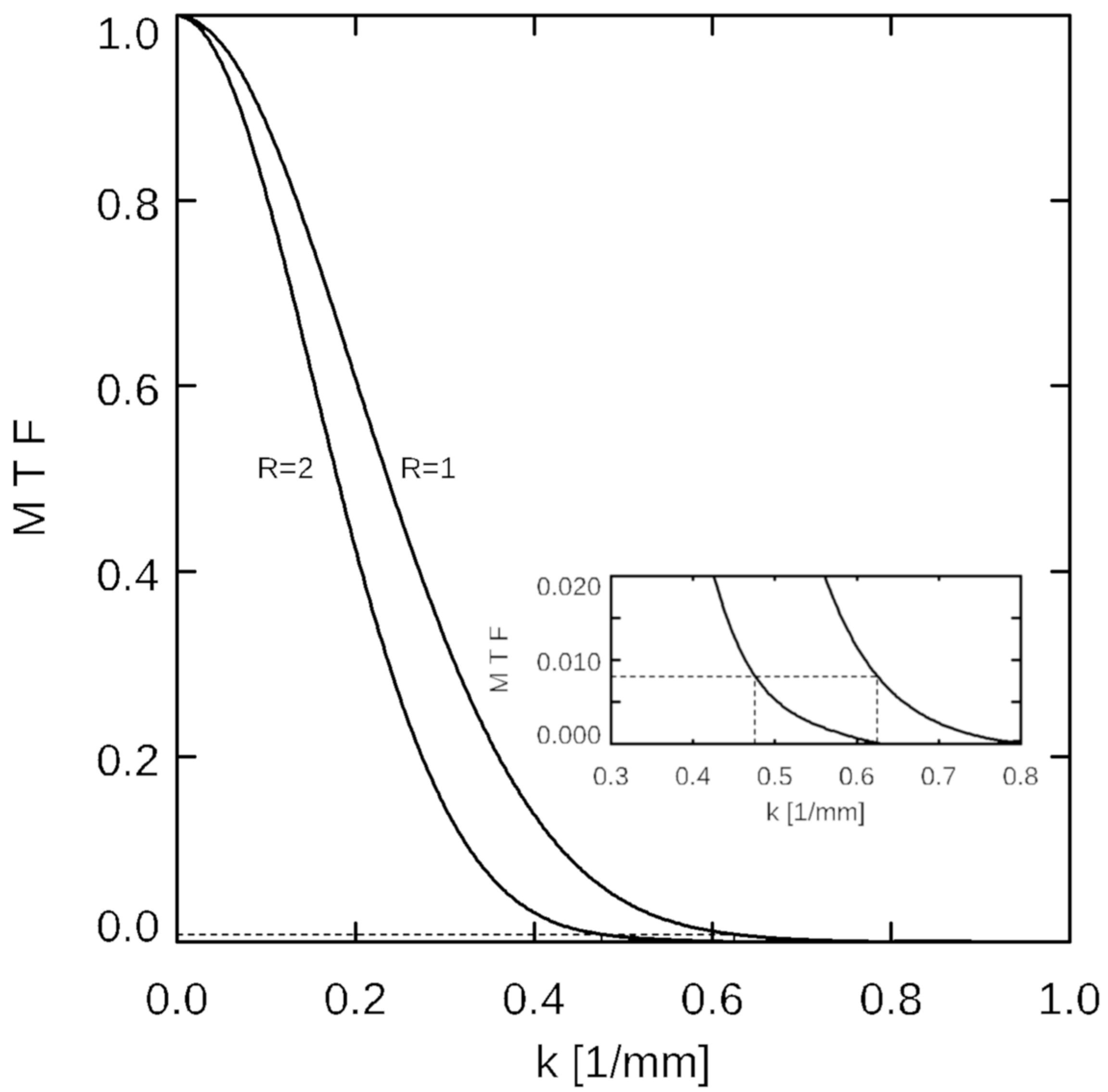
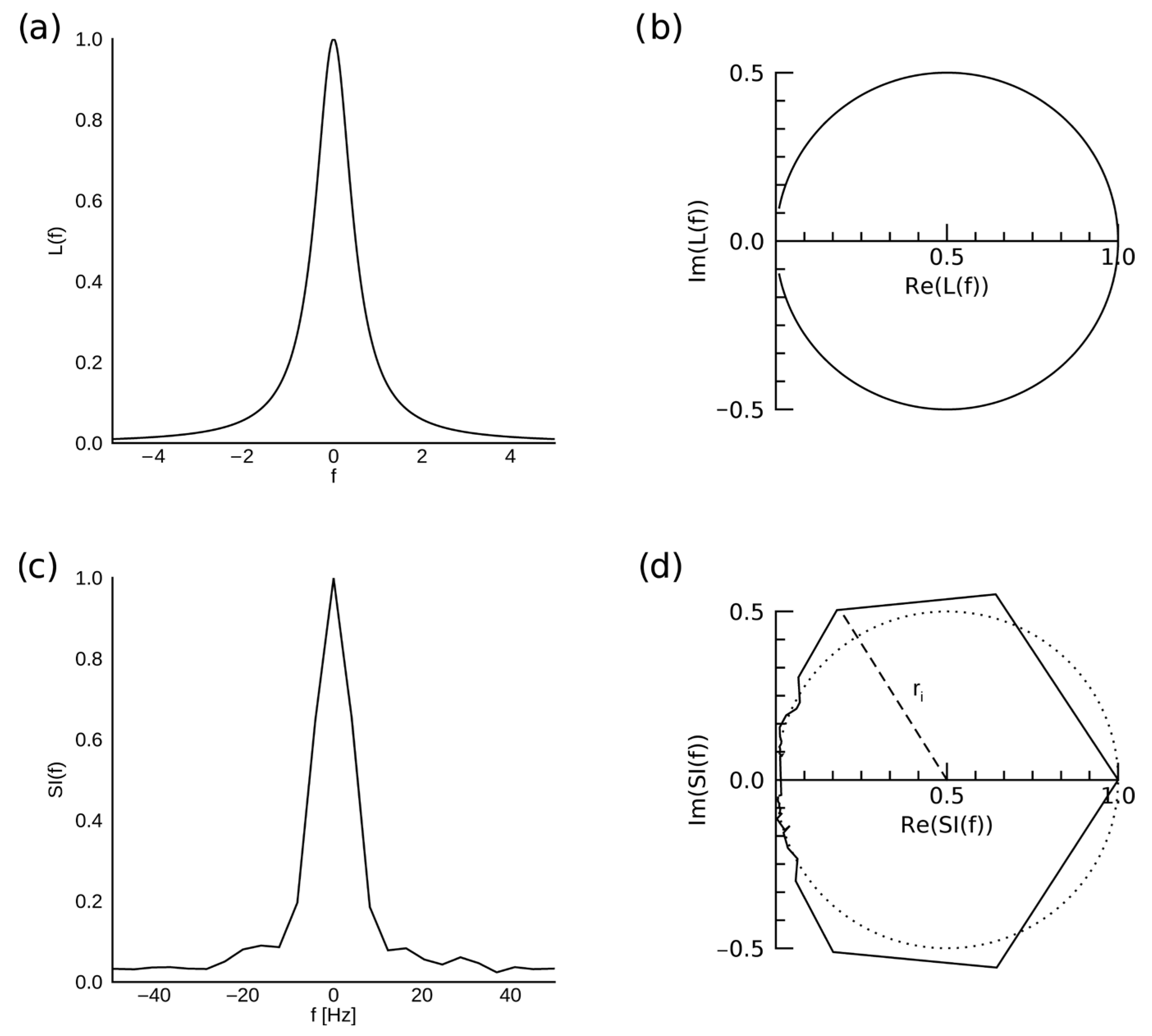

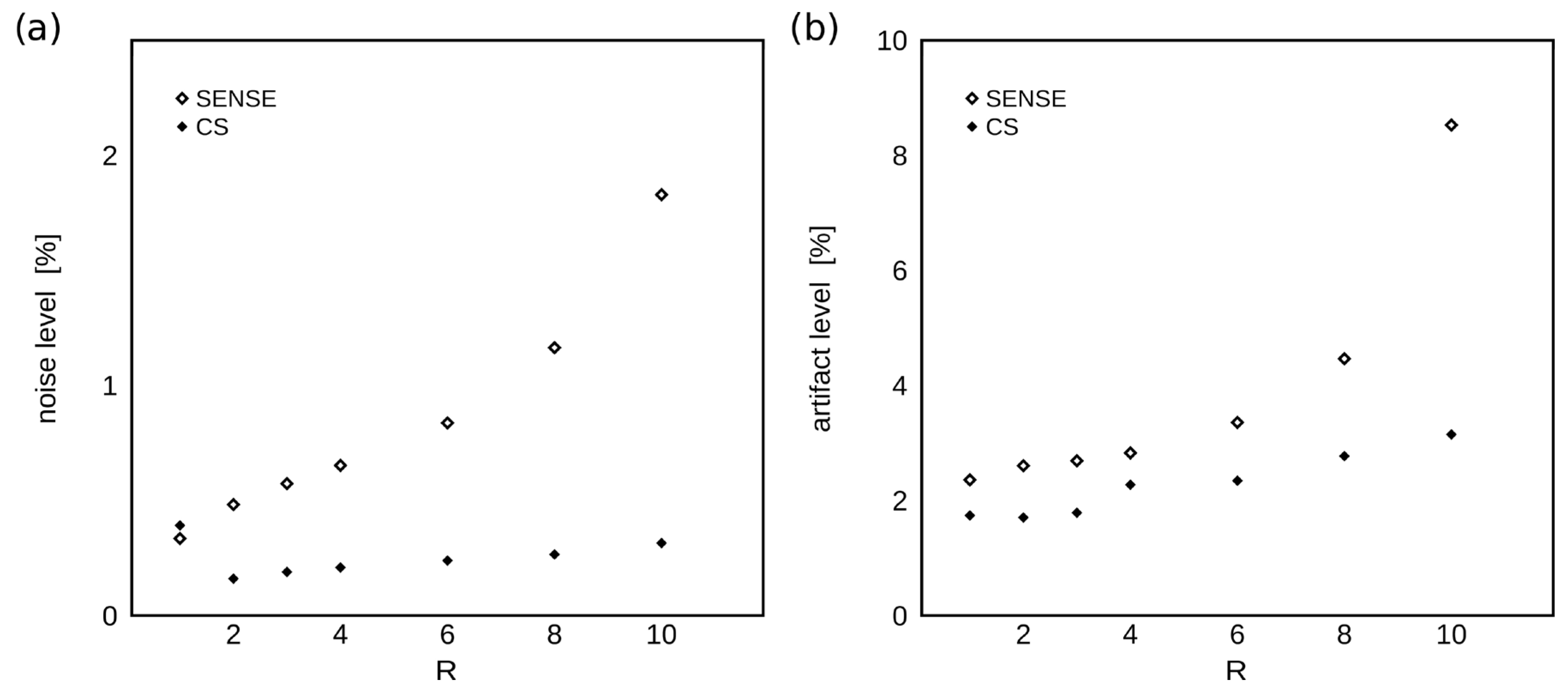
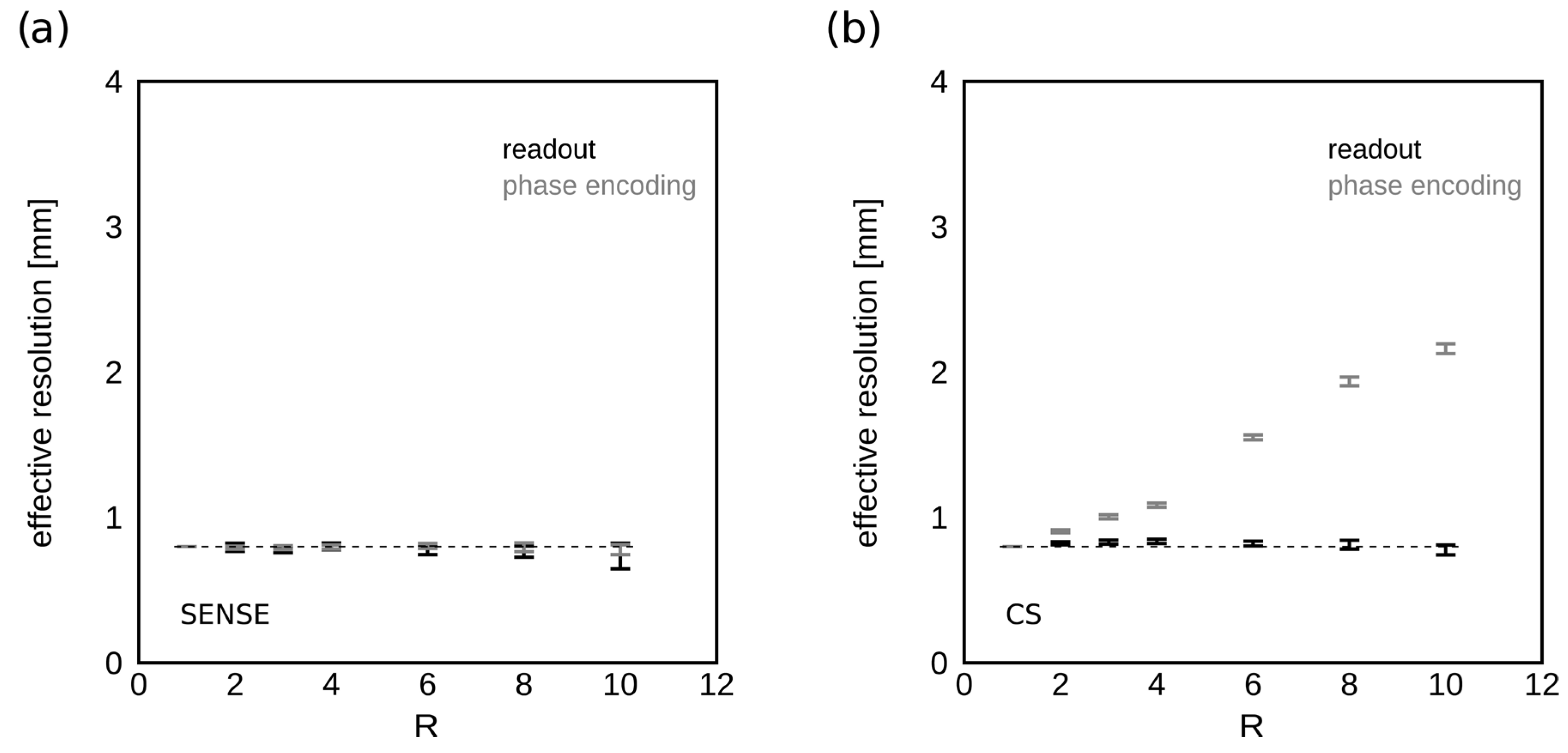
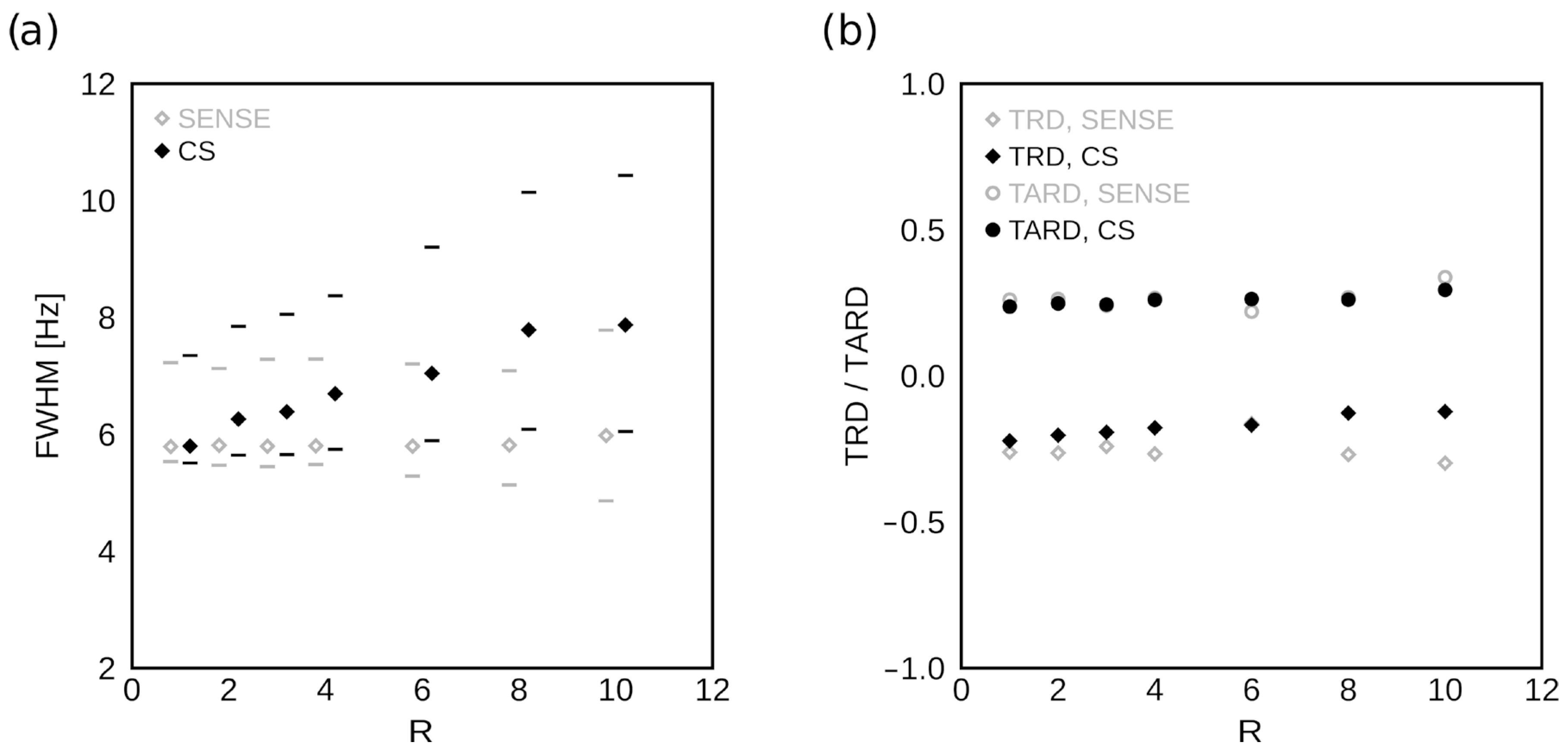
| Property | SENSE | CS | Likely Effect on Clinical Diagnosis |
|---|---|---|---|
| Artifact type | Noise amplification | Intensity modulation | CS preferred due to the spatially gradual artifact nature |
| Noise level | Increased | Suppressed | CS would allow more robust analysis |
| Artifact level in water-suppressed region | Higher | Lower | CS would allow more robust analysis |
| Spatial resolution | Preserved | Degraded in the phase-encoding direction | CS might compromise morphological/radiomics analysis |
| Spectral line width | Preserved | Degraded in areas of high B0 inhomogeneity | CS might compromise spectral analysis |
| Spectral line shape | Preserved | Preserved | Neither method is preferred |
Disclaimer/Publisher’s Note: The statements, opinions and data contained in all publications are solely those of the individual author(s) and contributor(s) and not of MDPI and/or the editor(s). MDPI and/or the editor(s) disclaim responsibility for any injury to people or property resulting from any ideas, methods, instructions or products referred to in the content. |
© 2023 by the authors. Licensee MDPI, Basel, Switzerland. This article is an open access article distributed under the terms and conditions of the Creative Commons Attribution (CC BY) license (https://creativecommons.org/licenses/by/4.0/).
Share and Cite
Medved, M.; Vicari, M.; Karczmar, G.S. Characterization of Effects of Compressed Sensing on High Spectral and Spatial Resolution (HiSS) MRI with Comparison to SENSE. Tomography 2023, 9, 693-705. https://doi.org/10.3390/tomography9020055
Medved M, Vicari M, Karczmar GS. Characterization of Effects of Compressed Sensing on High Spectral and Spatial Resolution (HiSS) MRI with Comparison to SENSE. Tomography. 2023; 9(2):693-705. https://doi.org/10.3390/tomography9020055
Chicago/Turabian StyleMedved, Milica, Marco Vicari, and Gregory S. Karczmar. 2023. "Characterization of Effects of Compressed Sensing on High Spectral and Spatial Resolution (HiSS) MRI with Comparison to SENSE" Tomography 9, no. 2: 693-705. https://doi.org/10.3390/tomography9020055
APA StyleMedved, M., Vicari, M., & Karczmar, G. S. (2023). Characterization of Effects of Compressed Sensing on High Spectral and Spatial Resolution (HiSS) MRI with Comparison to SENSE. Tomography, 9(2), 693-705. https://doi.org/10.3390/tomography9020055







